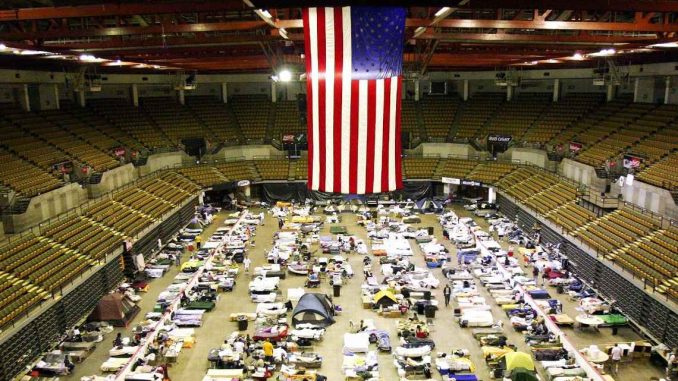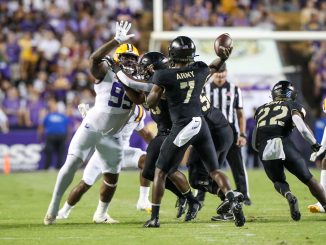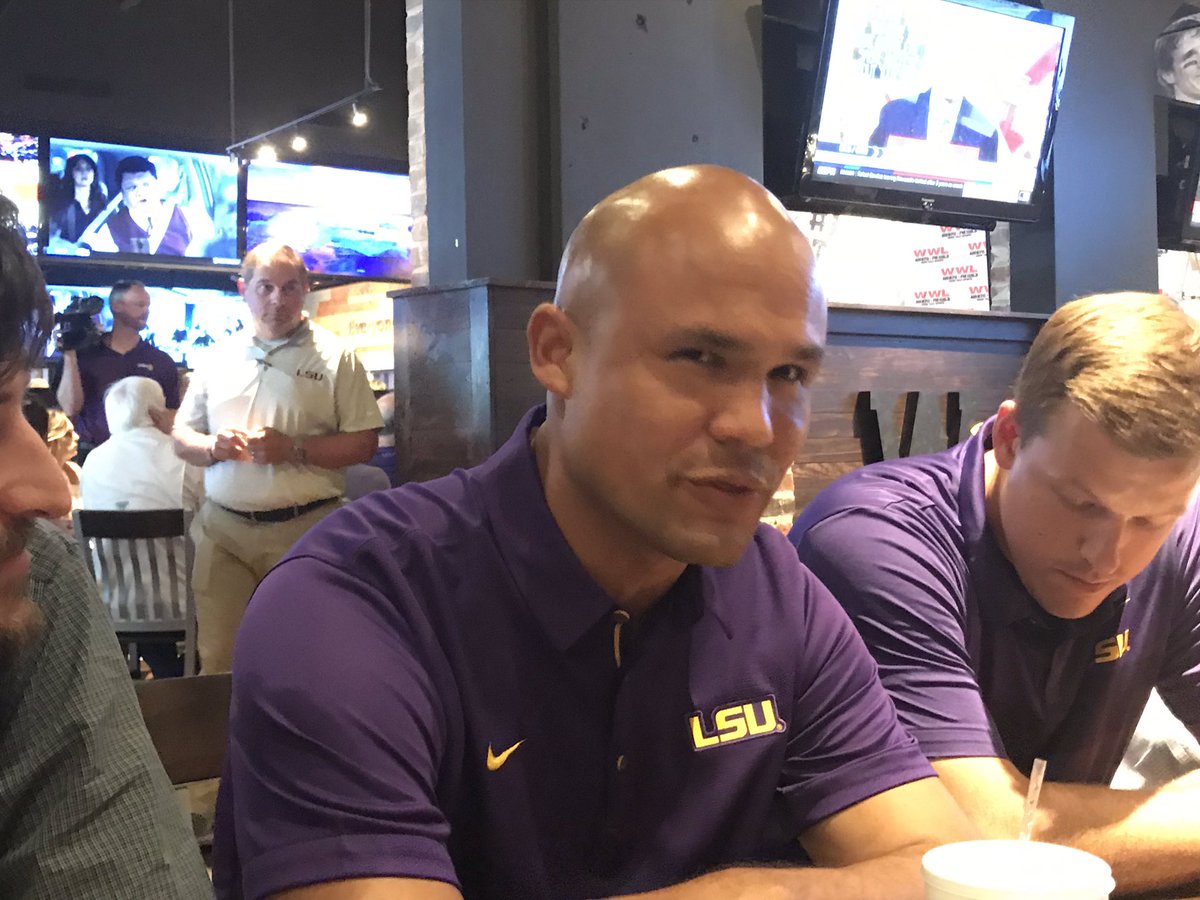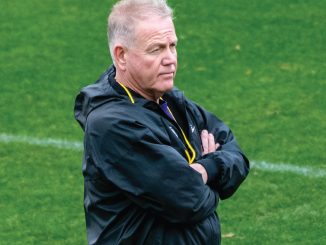
GLENN GUILBEAU, Tiger Rag Editor
(Reprinted Glenn Guilbeau column in USA Today Louisiana papers on Aug. 29, 2015.)
NEW ORLEANS – On the night of Friday, Aug. 26, 2005, I smoked a postgame cigar in the Smith & Wollensky restaurant bar across Poydras Street from the Louisiana Superdome. I needed a pick-me-up after watching the New Orleans Saints lose in depressing fashion, 21-6, to the Baltimore Ravens, foreshadowing many more midnights weary and dreary for months and years to come in the City That Care (And the Federal Government) Forgot.
The bartender was talking about taking her kids to the Blue Bayou water park in Baton Rouge the next day.
But a message on the Superdome scoreboard late in the fourth quarter had just warned of an approaching hurricane named Katrina. But it didn’t seem to register to most. One writer in the press box even asked, “What’s that hurricane’s name?”
By 6:10 a.m. on Aug. 29 when the storm made landfall at Buras and soon after, most everyone knew Katrina as New Orleans became a water park of the worst kind with a final fatality count of 1,392 and $125 billion in damages. The following 10 Katrina quotes from that time cannot be evacuated.
1. “Brownie, you’re doing a heck of a job.”
… President George W. Bush shortly after Katrina to Federal Emergency Management Agency (FEMA) director Michael Brown, who clearly was not doing his job and previously was the director of the International Arabian Horses Association. No Arabian horses were harmed by Katrina.
Brown became the whipping boy of the Bush presidency’s slow-motion reaction to the storm, which took nearly a week for the White House to do anything of significance. But it was Bush who previously had ridiculously appointed the hopelessly under-qualified Brown to a very important job, instead of making him ambassador to Rhode Island. Michael Chertoff, who was Bush’s Secretary of Homeland Security, also did a poor job before, during and after Katrina. So did top government officials in New Orleans and Baton Rouge, but those with bigger jobs deserve much of the blame as well.
2. “Anyone who makes a living as a professional musician owes a debt to New Orleans. The roots of jazz, blues and rock ‘n’ roll can all be traced to this region.”
… U2 guitarist David Howell Evans, aka The Edge, to CNN after the storm. Evans came to New Orleans to help and could be seen playing little-known clubs like Banks Street Bar in the weeks after Katrina, sometimes in front of just 20 or 30 folks. He went on to raise money for relief efforts.
3. “We finished the night hauling boxes of body bags, and more were on the way. As we left, a man was rolled in on a stretcher and, scarily enough, had suffered gunshot wounds. The paramedic said he was shot several times because a looter needed his boat, and he wouldn’t give it to him. He was unconscious and later pronounced dead. A man with him said it was ‘an uncivilized society in New Orleans no better than Iraq right now.’ I left as they were rolling a 3-year-old kid in on a stretcher. I couldn’t take it anymore.”
… LSU Sports Information Department student assistant Bill Martin after volunteering at LSU’s Pete Maravich Assembly Center, which was converted into a MASH unit field hospital post Katrina with a morgue on the ground level basketball court below the main floor.
4. “All the bridesmaid dresses are gone. We may have to postpone the wedding.”
… Michelle Millhollon, who was scheduled to become Mrs. Glenn Guilbeau on Jan. 14, 2006, unless we didn’t get some new dresses fast. They had been ruined by flood waters at a Metairie dress shop, and we learned that the dress shop owner went into hiding from various Bridezillas because of ruined dresses for other weddings. My mother, Carmen (LeBleu) Guilbeau of Fenton, and sister-in-law Kathy (Moran) Guilbeau, turned gumshoe detectives and somehow located the incognito dress shop owner and retrieved Michelle’s beautiful bridal gown, which the owner had fortunatley spared. New bridesmaid dresses had to be purchased elsewhere, and the wedding went on in Thibodaux. Groom and groomsmen wore Black and Gold, Fleur-De-Lis ties for the city. The afterparty and honeymoon happened at the Marriott on Canal Street in New Orleans amid military vehicles outside and the National Guard inside.
5. “Is there still water in New Orleans?”
… An out-of-state wedding invitee months post-Katrina obviously suffering from too much storm coverage.
6. “This is for everybody in this city. This stadium used to have holes in it and used to be wet. It’s not wet anymore. This is for the City of New Orleans.”
… Sean Payton after his Saints beat Minnesota, 31-28, in overtime on Jan. 24, 2010, to win the NFC championship and reach the city’s first Super Bowl.
7. “You’re with us in San Antonio or you’re not with us.”
… Saints’ owner Tom Benson in a memo to employees after the Saints “temporarily” relocated post-Katrina to San Antonio, where Benson held many business interests for decades and wanted to move the franchise permanently. Benson fired Saints vice-president Arnold Fielkow for saying at a press conference the week of the Saints-Dolphins game in Tiger Stadium (moved because the Superdome roof was shredded by Katrina) that he wanted the Saints to stay in New Orleans. Benson had been considering a move to San Antonio well before Katrina to force the state to build him a new stadium. And he tried to take advantage of the storm as his exit launch. But NFL commissioner Paul Tagliabue blocked his butt like a good levee. The Superdome got repaired largely from federal money – not Benson’s pocket. And the rest is history. The Saints returned to the beautifully rebuilt dome in the 2006 season with Saints PR trying to credit Benson. They beat Atlanta after Steve Gleason blocked a punt, reached the NFC title game, then won the NFC title in the 2009 season in the dome and won the Super Bowl in Miami.
8. “Four nights and five days.”
… LSU tailback Leonard Fournette repeated when asked how long he and his family lived on the Interstate 10-Claiborne Avenue Overpass in New Orleans after Katrina when he was 10. It took Bush that long to get the cavalry to New Orleans.
9. “I saw some sights I never thought I’d see in an American city. The criminal ineptitude makes you furious.”
… Bruce Springsteen at the New Orleans Jazz & Heritage Festival on April 30, 2006, as he set up his next song after having visited the still-ravaged 9th Ward the day before. He sang, “How Can a Poor Man Stand Such Times and Live,” and dedicated it to “President Bystander.”
10. “I should have recognized the deficiencies sooner and intervened faster. The problem was not that I made the wrong decisions. It was that I took too long to decide. When the pictures were released (of Bush viewing the devastation from Air Force One I, instead of visiting the city immediately as President Lyndon Johnson did after Hurricane Betsy in 1965), I realized I had made a serious mistake. Just as Katrina was more than a hurricane, its impact was more than physical destruction. It eroded citizens’ trust in their government. It exacerbated divisions in our society and politics. And it cast a cloud over my second term.”
… Former President George W. Bush in his 2010 memoir, “Decision Points.”




Be the first to comment